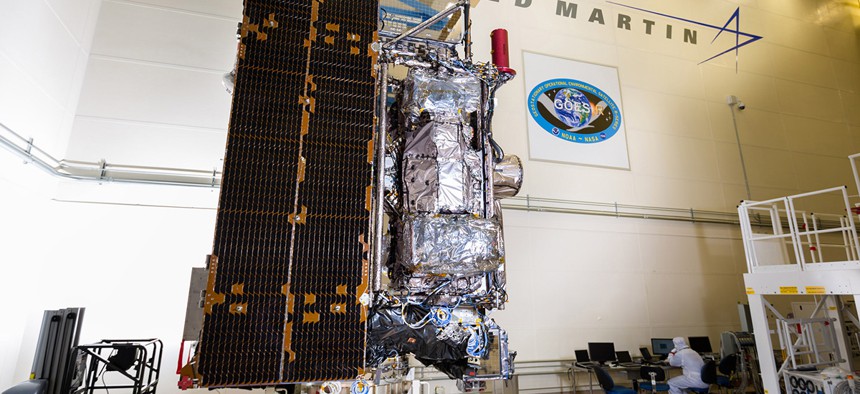Next-Generation Weather Satellites Going Up in October. But What’s Coming Down?

The fully assembled GOES-R satellite with its solar array stowed, in a clean room at Lockheed Martin. NOAA
The GOES-R constellation will replace the existing GOES fleet, which consists of a backup satellite and two active satellites that monitor the U.S. 24/7.
If all goes according to schedule, the first of the U.S. government’s next-generation geostationary satellites – the Geostationary Operational Environmental Satellite, or GOES-R – will launch this October from Cape Canaveral, Florida.
What happens from there, though, is still up in the air.
The GOES-R constellation will replace the existing GOES fleet, which consists of a backup satellite and two active satellites that monitor the U.S. 24/7. GOES-15 and GOES-13 fly at 22,000 miles above the west and east coastlines, respectively.
At the moment, Vanessa L. Griffin, director of the National Oceanic and Atmospheric Administration’s Satellite and Product Operations, said the weather agency has not yet determined which old satellite GOES-R will replace.
“We have not said where it is going yet,” Griffin said in an interview with Nextgov. “We will decide it within the first six months after we launch it. It’s really going to depend on what the constellation health is.”
At the moment, Griffin said “GOES-13 is probably our weakest satellite.” It was briefly shuttered a few years ago when a micrometeoroid impact caused it to shut down. One of GOES-13’s primary instruments, called the Sounder, is also not working, though that isn’t terribly problematic for NOAA, because most atmospheric sounding data can be collected from GOES-15.
After GOES-R is launched in October, Griffin said NOAA will essentially leave it in a “check-out position” as scientists and engineers “check out all the systems and products and make sure they’re working.”
Once GOES-R is fully operational, NOAA officials can move slowly to either a western or eastern orbit.
GOES-13 may be more likely to be replaced than its western counterpart, but both current GOES satellites will be running beyond their estimated life expectancies. Griffin said if GOES-13 were to fail before GOES-R is operational, NOAA would be forced to reactivate GOES-14 – currently the GOES constellation’s backup – to replace the eastern satellite, which could send GOES-R westward.
“It makes for a more complicated operational swap for the satellites,” Griffin said.
There are other pros and cons that’ll have to be weighed by NOAA’s leadership even if the current GOES satellites continue to operate satisfactorily, Griffin said.
GOES-R and its hypermodern instruments will give NOAA a gargantuan leap in weather forecasting capabilities, but the positioning of the satellite over either coast offers various benefits to various factions of the weather agency.






